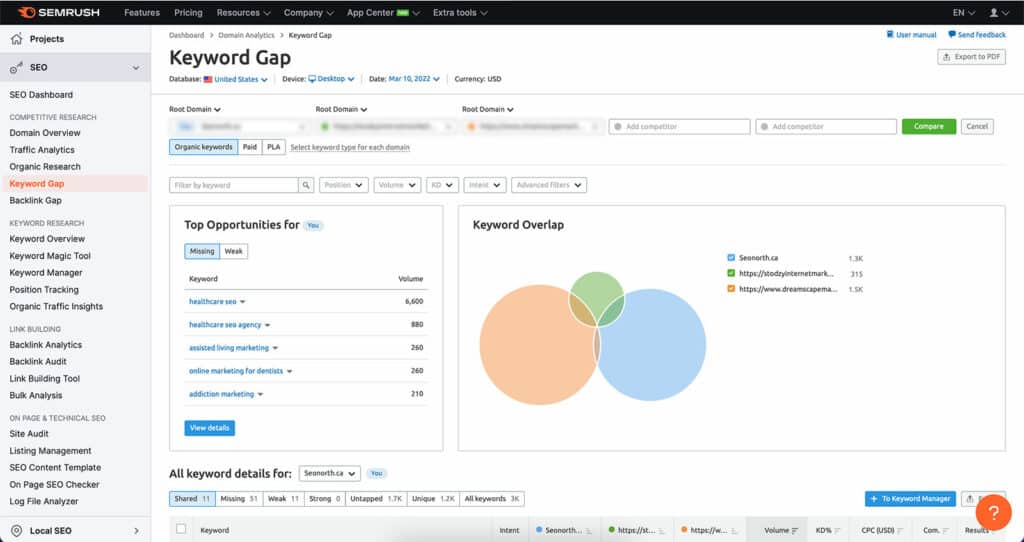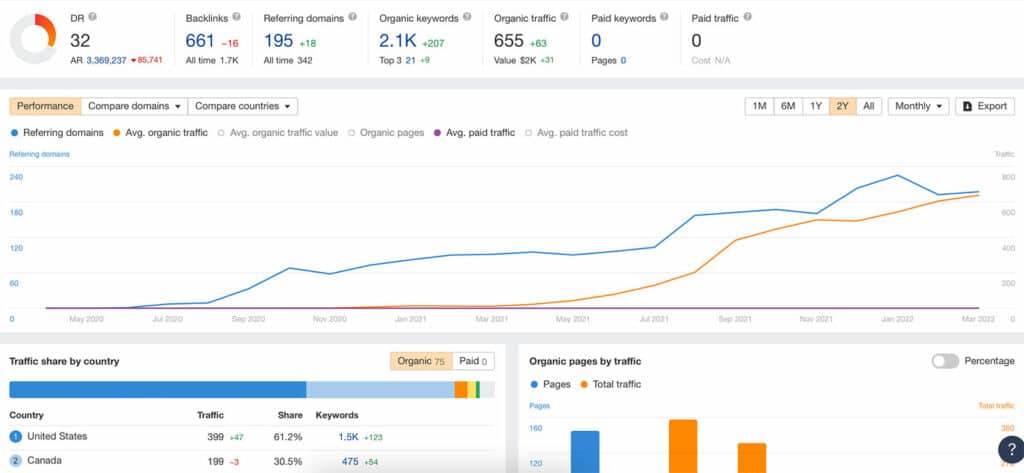When you plan your SEO strategy, staying true to your brand identity and message is essential. However, you must know what your competition is doing to position yourself ahead of them. An SEO competitive analysis allows you to identify what metrics bring traffic to top websites in your niche, capitalize on your competitors’ weaknesses, and outperform other companies in your industry.

Table of Contents
Who Are Your SEO Competitors? The SEO competitor Analysis
Before analyzing your competitors’ SEO status, you have to benchmark who you’re up against. If you ask a business owner who their competition is, they’ll probably be able to rattle off a list. But your general competition is different from your SEO competitor’s rank.
For example, if you sell organic cotton leggings, you might think your primary competitor is the dance apparel store down the street. But they don’t even have a website, so they pose no SEO competition. On the other hand, an online yoga mat shop ranks highly for “yoga gear” and “organic yoga pants.” This is your SEO competition.
The Answers Are At Your Fingertips
SEO analysis is all about uncovering the facts. Guessing will get you nowhere. You can begin your SEO analysis manually or with the help of software.
A simple way to identify your competitors is to enter your top keywords into a search engine. As you perform search queries for different keywords, record the websites that rank on the first page. You can track this in a spreadsheet (excel or g-sheets). The sites that appear most frequently and in the highest positions are the ones that are doing things right.
Domain Analysis Tools
This strategy can be inaccurate and tedious. Moz’s free domain SEO analysis tool provides competitive keyword data much faster. Enter your website into the device, and the software will display the competitor’s rank organized by:
- Top pages based on page authority
- Top linking domains (referring domains)
- Discovered and lost linking domains over the past 60 days (link profile)
- Keywords by estimated clicks
- Top ranking keywords
- Top featured snippets
- Branded keywords
- Top search competitors
Once you have used this tool to gather information about your website, you can enter your top competitors’ website URLs into the search bar to continue your analysis.
Several SEO tools are available for conducting competitive research and analyzing Keyword difficulty. Others include:
Talkwalker Quick Search is similar to Google Search but allows you to pull up a snapshot of a brand across social media platforms, blogs, forums, and news websites. You’ll be able to spot trends in real-time, see what your target audience is responding to, and fill gaps in your content and SEO strategy.
Your SEO should inform your social strategy and vice versa. Monitoring your competitors’ activity can keep you inspired and moving in the right direction.
Breaking Down Competitor Keyword Rankings

When you search for your competitors, you want to identify the keywords they rank highly for. Record all of these. Then, select the highest keyword rankings that are valuable and relevant to your brand. Some questions to ask yourself include:
- Does my website rank for these target keywords?
- How difficult would it be to outrank the competitors’ content?
- Are there high-value topics my site should rank for (content gap analysis)?
You don’t just want to use the exact keywords as your competitor’s sites. Some of them might not be effective. Research each keyword phrase to determine its search volume and amount of competition. This step-by-step guide will help you to rank higher, get more traffic, and earn more conversions.
Understanding which keywords to create high-quality content gives you ideas for posts and web pages. You can take your keyword analysis further by using free keyword research tools to generate lists of similar search terms. You will find other relevant keywords in the same category. Some of these may have a higher search volume and click rate than the keywords that your competition is using. Incorporate those in your content to rank even higher and generate additional traffic.
Competitor Link Analysis
External links are an essential search engine ranking factor. Other sites want to link to a website that offers valuable information. The more backlinks a website has from reputable, authoritative sites, the more likely it will rank highly for that content. Google rewards links to your website from other sites that rank highly.

SEO analysis tools and professionals can help you target your competitors’ pages with the most links pointing in their direction. Keep track of these. They will provide you with ideas for creating your valuable content. Record the number of backlinks a website has on the pages you want to compete with. Also, please make a note of who is linking back to them. You’ll use this information later.
High-ranking pages don’t just get that way from backlinks; they may be arranged to keep the target market engaged. As you conduct your research, keep track of the types of pages that are ranked highly. What type of content do they contain?
Some examples are:
- Listicles
- Reviews
- Comparison posts
- Product pages
- Landing pages
- Video tutorials
- Interactive content
The type of content is as important as the links and the keywords. The page type that works best is the one that pins down the intent of the query. If someone who finds your page while searching for a recipe is bombarded with photos of your last family Christmas, they may not stick around to try your recipe. A concise video might be better. But you don’t have to throw spaghetti at the wall to determine which option is best, and you have to scope out the competition.
You’ve Done the Research. Now What?
Now that you have identified your competitors’ top keywords and ranked pages, you can work on updating your site. You’re capitalizing on your competitors’ success. They’ve proven that these keywords effectively attract traffic and provide leads for other websites that link to pages like yours.
Implement what you learned from your keyword research by updating your content. While you shouldn’t copy anything from another website, you can mimic their content strategy by using similar keywords and types of content.

You wouldn’t want to plagiarize their content anyway. The goal is to optimize your on-page SEO, making yours better than theirs so that it ranks at the top of the search engine results pages or SERPs.
Although keyword placement is a complex strategy, the basics are as follows:
- Start by optimizing web pages that are already ranking well for high-value keywords.
- Use keywords in your tags, such as title, meta, and image.
- Incorporate keywords into website copy with a density of 1 to 3%.
- Create blog posts that answer short and long-tail keywords, filling your keyword gap.
- Pay attention to the pieces of content helping your competitors rank well and create similar types of content and word count.
- Make sure that the keywords are relevant to the rest of the information on the web page.
- Optimize other features of the web page that factor in search engine rankings, such as mobile responsiveness and loading speed.
- Continually watching for new keywords in organic search results.
Link building involves time-intensive tactics, and the process works, but it doesn’t deliver results overnight. The critical elements of a link-building strategy include:
- Creating content that’s better than what your competitors’ backlink profiles are pointing to; some ways to do this include increasing keyword density, providing more data, and increasing the length or organization of the content.
- Contact the linked website and offer your enhanced content as a resource; some sites will replace a competitor’s link with yours.
- Focusing on getting links from websites that are thematically relevant to yours to increase your domain authority.
- Remember that the best links are placed naturally within the website’s content, with accurate anchor text.
- Monitor other websites’ broken links; they negatively impact page rankings and provide an opportunity to link to your relevant content.
Download: SEO competitor analysis template
Keep Your Ego In Check
One common reason that businesses fail is that their leaders fail to analyze the competition. After all, you likely started the business because you thought you could provide something different. But you can’t assume that your tactics are the most effective if you’re unaware of your competitors’ SEO.
Operating out of a vacuum isn’t going to get you far in the world of SEO, where relevance to the consumer is vital. You must be in touch with your target market’s search behavior and the search engine ranking regulations and algorithms.
While the details are ever-changing, the main idea remains the same. The competitive analysis provides you with data that you can pattern your content after. While it won’t boost your rankings overnight, it can exponentially increase your organic traffic, clout, and visibility over time.
Resources
There are many tips and tricks for SEO, but not all apply to every website. That’s why I created this list of resources on how to perform a competitive analysis.
| COMPETITION ANALYSIS | ||
|---|---|---|
| The Guide to SEO Competitor Analysis | Guide | Moz |
| How to Do an SEO Competitive Analysis | Guide | Jennifer Slegg / SEMrush |
| How to Do an SEO Competitor Analysis [Template Included] | Guide | Joshua Hardwick / Ahrefs |
| Your Essential Guide to Crushing Competition [w/ Template] | Guide | Sam Underwood / Advanced Web Ranking |
| The SEO Competitive Analysis Tools & Tips 100+ Marketers Rely On Most | Guide | Elise Dopson / Databox |
FAQ
What is a Competitive SEO Analysis?
Published on: 2021-10-02
Updated on: 2024-06-16